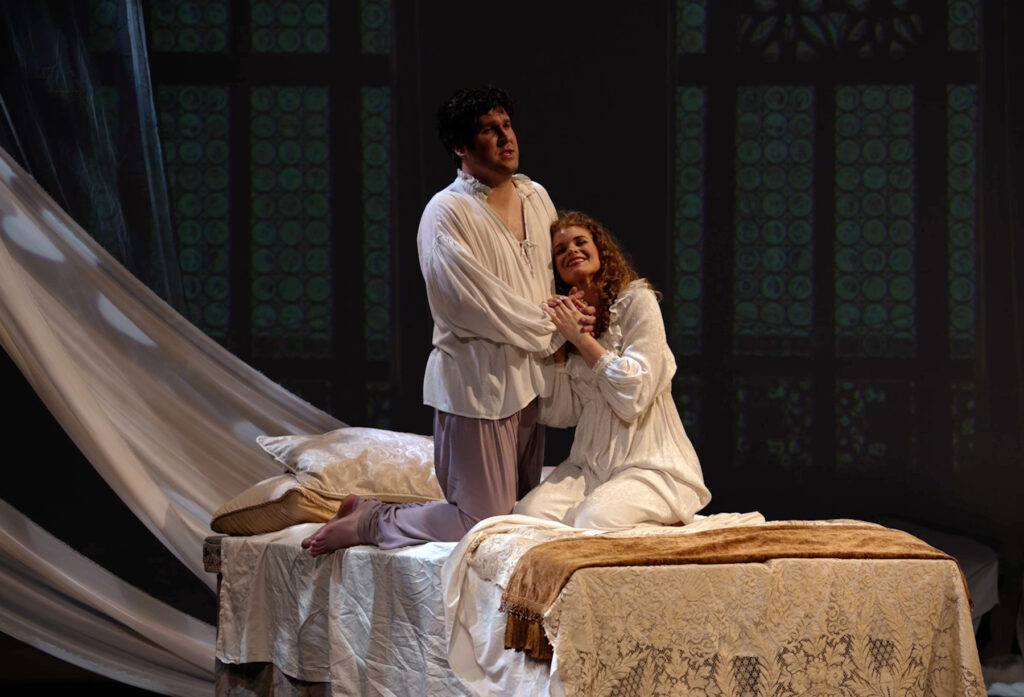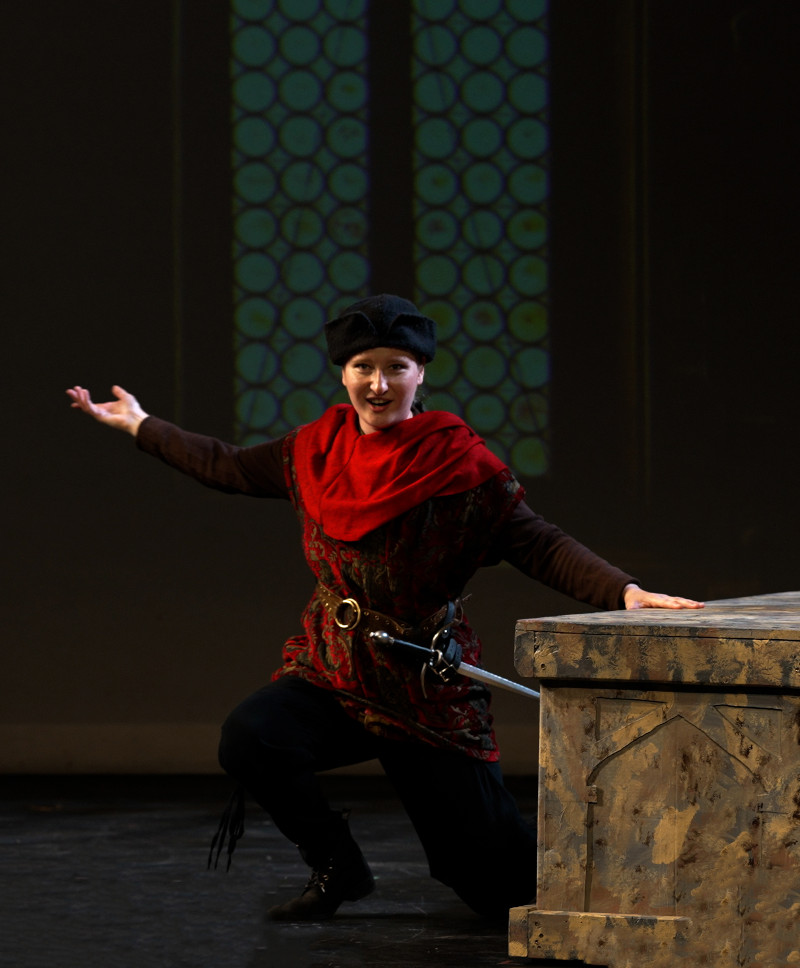For over 20 years now, Bel Cantanti Opera has been a staple of the opera scene in the Washington, D.C. area, and if you take in one of their productions you’ll quickly understand why. The principal artists they hire bring with them such credentials as being Washington National Opera Domingo-Cafritz young artists and winning the Metropolitan Opera Laffont competition, so there is no compromising on vocal quality—these truly are some of the finest voices you can hear in the area. It was with great anticipation, therefore, that I sat down to take in their production of Rómeo et Juliette.
The production opened with actor Justin Meyer delivering Shakespeare’s famous Prologue speech. Throughout the production, he delivered spoken exposition, some of it Shakespeare, some of it not. The exposition was in lieu of a chorus, in my opinion unfortunately not to the show’s advantage despite Meyer being a truly wonderful actor, because Gounod wrote some fantastic music for the chorus. I would have loved the show to have retained that chorus, because even with the small cast, I found the little bit of chorus music that they did sing at the beginning of the show to be effective. The only issue was that, sitting in the center of the auditorium, I could not read the translation that was being projected on the screen behind the cast in the prologue. It was not merely supertitles but a scrolling text that translated what was being sung, and the combination of set pieces and where the actors were standing meant that the text got obscured. Fortunately, the supertitles for the rest of the show were clear—I had no more trouble seeing them after the prologue.

The set for the show included two biers that changed position depending on the scene, beautiful white sheer curtains draping everywhere, Montague and Capulet family portraits hanging on both sides of the stage, and projections on the cyclorama. The white curtains especially gave the set the same dreamlike quality of Gounod’s score. My favorite scenes were the bedroom and tomb scenes because of how they used the curtains and biers. The white sheets of Romeo and Juliet’s bed combined with the white curtains made it seem as if the couple was in heaven, illustrating their connubial bliss. The positioning of the biers for the tomb scene was classic, really bringing the show full circle.
Now, on to the music. As I mentioned before, with Bel Cantanti there is no compromising on vocal quality, so every cast member sings exceptionally well, and the same high quality holds true for the orchestra. Director Dr. Katerina Souvorova leads an ensemble that, although reduced compared to a full-size orchestra, more than does justice to the score. In my opinion, they hit all the marks that I wanted to hear and gave a beautiful, full sound throughout the performance. In particular, and by way of example, one of the first most memorable moments was Juliet’s first aria “Je veux vivre.” Although this is an aria one hears many, many times in the course of studying and watching opera and following the careers of singers, when done correctly it never loses is excitement, and one key element of that is the orchestra.

The other element necessary to an exciting “Je veux vivre” is the soprano. In this production the role of Juliet was double-cast, and on the afternoon I attended I saw Emily Casey. If you’ve heard her before, you know what a wonderful instrument and presence she possesses, and this role is no exception. She embodied Juliet’s character and grabbed the audience’s attention in that aria, eliciting well-deserved thunderous cheers and applause from her sparkling rendition. Vocally, she and her Romeo Nicholas Hudak seemed well-matched, neither overpowering the other in their scenes together. I thought Hudak’s powerful voice well-suited to the role and look forward to hearing more of him and Emily in the future.
Another double-cast role I got to see at this performance was that of Stéphano, Roméo’s page. Mezzo-soprano Alla Salakhova brought the right sense of boyishness to this trouser role, and not only sang the aria “Que fais-tu, blanche tourterelle” expertly, but also made me laugh with her acting, which I loved in a show that ultimately is a tragedy. Full commendation to her for creating such a memorable moment!
One final thing to note about this performance: the fight choreography by Casey Kaleba. It should come as no surprise, since he works with Washington National Opera in addition to other companies in the area such as Shakespeare Theatre Company, that he makes his fights look great. The confrontation between Tybalt, Mercutio, and Romeo I felt was appropriately chaotic and well-executed.
In summary, this was an entertaining Roméo et Juliette and an afternoon well-spent. I recommend this company to anyone who has not yet experienced their productions. Next season Bel Cantanti performs Ravel’s L’enfant et les sortilèges, The Snow Queen, a Russian opera gala,and Donizetti’s Anna Bolena, and I have no doubt they will be just as memorable.
Maggie Ramsey
Roméo et Juliette
Music by Charles Gounod
Libretto by Jules Barbier and Michel Carré
Cast and Production Staff:
Romeo – Nicholas Hudak; Juliette – Esther Tonea, Emily Casey; Mercutio – Max van Wyck; Stephano – Anastasia Sidorova, Alla Salakhova; Frere Laurent – Noah Mond; Tybalt – Dashiell Waterbury; Gertrude – Madeline Manaker; Narrator – Justin Meyer.
Stage Director, David Toulson, Producer: Katerina Souvorova. BCO Orchestra directed by BCO Artistic Director Dr. Katerina Souvorova.
All photos by Alexander Souvorov, courtesy of Bel Cantanti Opera Company